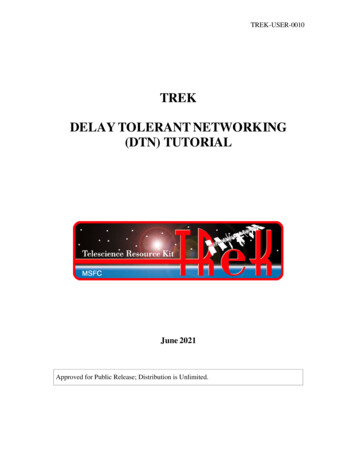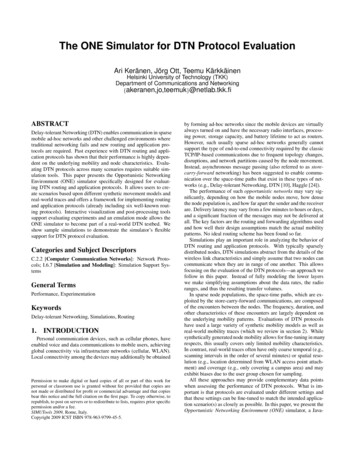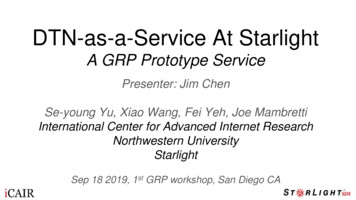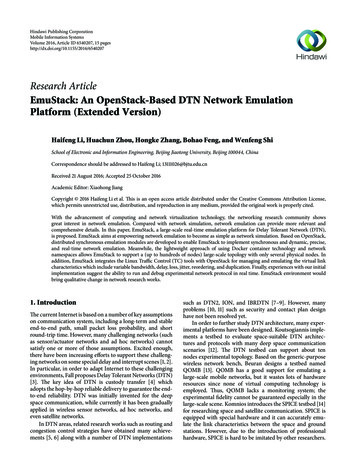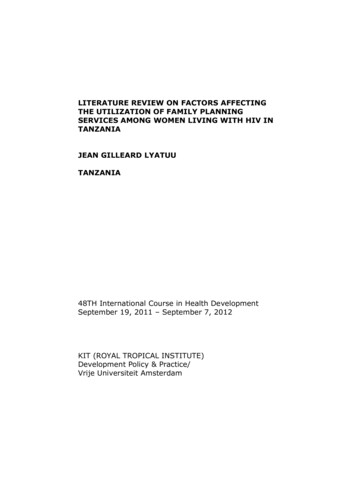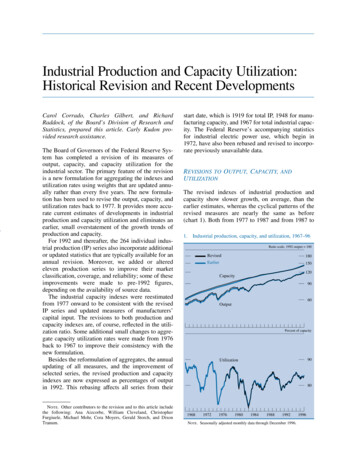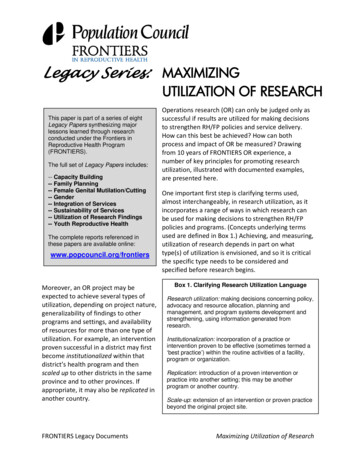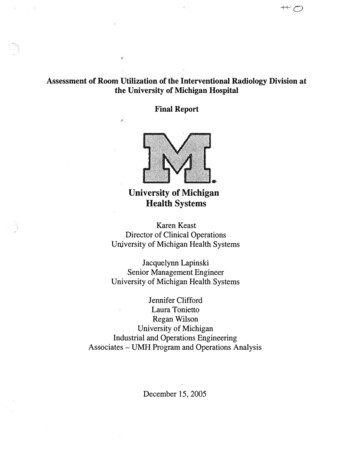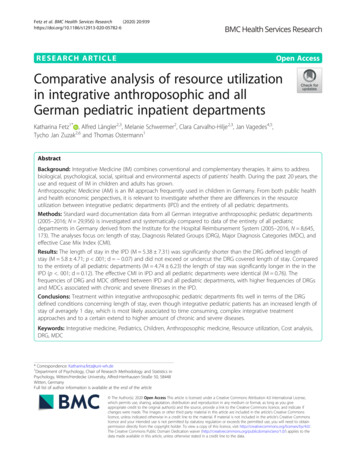
Transcription
NASA MSFCMission Operations LaboratoryMSFCDTN Implementation andUtilization Options on theInternational Space StationKelvin NicholsMark HolbrookLee PittsKevin GiffordAndrew JenkinsSebastian KuzminskyNASA MSFCMission Operations LaboratoryMSFC
Outline Brief introduction of the current communicationsarchitecture of the ISS How current payload operations are handled in the nonDTN environment Making the case to implement DTN into the current payloadscience operations model Phase I DTN Operations: early implementation withBioServe’s CGBA Payload Phase II DTN Operations: Developing the HOSC DTNGateway ConclusionNASA MSFCMission Operations LaboratoryPage 2Page 2MSFC
Introduction ISS Supporting Ground system Space links are based on CCSDS silver standard S-band used for low bandwidth Uplink/downlink Primary payload command uplink path Approximate uplink rate of 38 Kbps Ku-band used for high bandwidth Telemetry downlink Primary downlink path for payload telemetry Approximate downlink rate of 50 Mbps Harsh environment of space presents a new set of problemsover traditional IP networks AOS/LOS scheduling issues Radiation Sharing downlink with other spacecraft Ground transport is over IP networks Payload data is distributed to users via UDP Remote commanding is encrypted over VPNNASA MSFCMission Operations LaboratoryPage 3Page 3MSFC
IntroductionNASA MSFCMission Operations LaboratoryPage 4Page 4MSFC
The non-DTN environment Primary function of the HOSC to support Payload Investigators and the corresponding science Tools and protocols have been utilized so PI can command and receive datanay place in the world UDP/TCPHTTPSRSHFTP Also support Command and Control applications for PayloadInvestigators TCP based and wrapped in secure envelope of IPSEC compliant VPN The C&C and Payload science distribution are handled in parallel Science distributed through PDSS via UDPDown-linked CCSDS data is constrained to it’s max sizeEHS header pre-pended to expedite processingUsers can request missed data through a user scheduled playbackScience distributed through PDSS via UDPDown-linked CCSDS data is constrained to it’s max sizeEHS header pre-pended to expedite processingUsers can request missed data through a user scheduled playbackNASA MSFCMission Operations LaboratoryPage 5Page 5MSFC
Making the case to implement DTN DTN would greatly help with the issues related to scheduledaround planned communication outages Several important considerations were part of the design Wanted to support the needs of our ever changing user base Current HOSC model works best with a control center on ahighly available network However the HOSC has many smaller centers and experiments thatdon’t want to staff continuously A DTN environment would better suit a type of on demand service User would not have to be online 100% of the time to receive data Would just pick it up the next time he/she logs into the system Also user would not need to be up all the time for commandingeither User could log in once with a set of commands that needed to besent, then log off and be assured that they would be deliveredonboard when a window was availableNASA MSFCMission Operations LaboratoryPage 6Page 6MSFC
Phase I DTN Operations: The HOSC partnered with CU-Boulder’s to create the first pathfinder DTN experiment onboard ISS CU-Boulder was able to repurpose it’s CGBA (CommercialGeneric Bioprocess Apparatus) experiment and install the IONversion of DTN code The HOSC developed a DTN command queue to allow Cadremanagement of DTN acknowledgments This is not really a DTN node but more like a priority queue When opportunity presents itself on commanding link, theseacknowledgments would then be forwarded through JSCcommanding to go back up to CGBA payload to confirm groundreceipt This style of special queued commands was different from thenormal operations concept used in the POIC Had to keep ground station operators informed during this phaseto allow them to be ready for the new way DTN commandingwould be allowed to circumvent the traditional commandingNASA MSFCconceptMission Operations LaboratoryPage 7Page 7MSFC
DTN I Early results: The modified ground software was deployed in the Apriltime frame of 2009 First DTN experiments from CGBA followed in the June 2009timeframe First experiments involved down-linking pictures from a previousCGBA experiment. More extensive test were performed after this first round ofexperimentation was successful The new experiments were to test how the payload wouldrespond to unattended operations Status telemetry files were down linked using non-DTN andDTN paths Non DTN scheme yielded an average of 3504 redundant receptionsper file DTN scheme yielded an average of 0.06 redundant receptions perfileNASA MSFCMission Operations LaboratoryPage 8Page 8MSFC
DTN Phase I: ImplementationNASA MSFCMission Operations LaboratoryPage 9Page 9MSFC
Phase II DTN Operations: HOSC is in the process of developing it’s own DTN nodeusing a phased approach: Initial development and evaluationDTN Engineering Network (DEN) testingDEN testing with CGBA using recorded dataIV&V testing with recorded and live dataOperational data flowNASA MSFCMission Operations LaboratoryPage 10Page 10MSFC
Phase II DTN Operations: Initial development was performed using DTN2 instance Testing with the CGBA ION DTN implementation uncoveredsome issues Related to ION and DTN2 interoperability Also related to some unique ways that communications areimplemented onboard the ISS To handle these issues a Convergence Layer Adaptor (CLA)was implemented unique to the ISS The CLA identifies and extracts the embedded BioServe RICchannel packets and then extracts the BP bundle set The packets are then processed by the DTN2 daemon for bundleseparation, forwarding, custody transfers, and any otherprocessingNASA MSFCMission Operations LaboratoryPage 11Page 11MSFC
IV&V Data FlowNASA MSFCMission Operations LaboratoryPage 12Page 12MSFC
High Available DTN configuration It will support multiple routers in a prime and backup mode The use of shared Redundant Array of Independent Disk(RAID) Will allow HOSC to support End-to-End DTN traffic fromCGBA Configuration also preserves the separation scienceDownlink and S-Band commandingNASA MSFCMission Operations LaboratoryPage 13Page 13MSFC
Highly Available DTN ConfigNASA MSFCMission Operations LaboratoryPage 14Page 14MSFC
Future DTN work The next goal is to break the separation described on theprevious slide. This will be accomplished it 2 phases: Encapsulate the Application Identifier (APID) and forwardwith custody transfer Pull out the bundle and perform a custody transfer Option 2 is preferred and the direction the HOSC ispursuingNASA MSFCMission Operations LaboratoryPage 15Page 15MSFC
Option 1NASA MSFCMission Operations LaboratoryPage 16Page 16MSFC
Option 2NASA MSFCMission Operations LaboratoryPage 17Page 17MSFC
Integrated Config to support both DTN and NonDTN usersNASA MSFCMission Operations LaboratoryPage 18Page 18MSFC
Conclusion Allows more diverse options for usersSupports new and innovative operations conceptsLeverages ISS as a test bed for new initiativeCan support various usersContinues the evolution of the ISSNASA MSFCMission Operations LaboratoryPage 19Page 19MSFC
NASA MSFC Mission Operations Laboratory. MSFC. Page 3. Page 3. Introduction ISS Supporting Ground system Space links are based on CCSDS silver standard S-band used for low bandwidth Uplink/downlink Primary payload command uplink path Approximate uplink rate of 38 Kbps Ku-band used for high bandwidth Telemetry downlink
